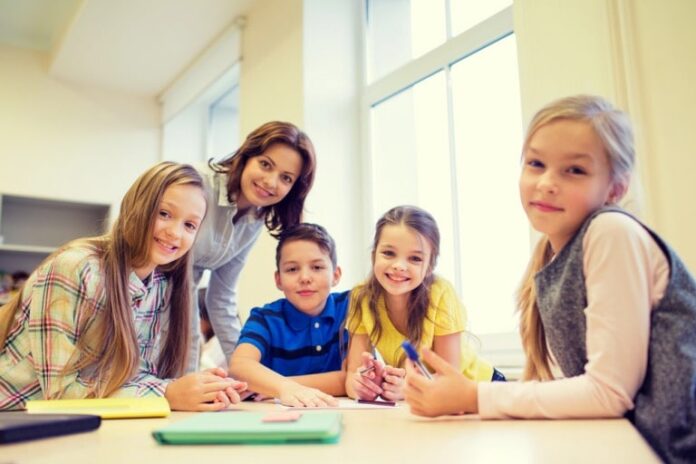Creating a dynamic and entertaining classroom is essential in capturing the interest of your students and enhancing their learning experience. Incorporating interactive activities and technology can significantly boost student engagement.
Whether it’s through classroom games that stimulate competitive spirit, or using digital tools that you integrate into your lessons, making learning fun can transform your teaching environment. Students of all ages benefit from a vibrant classroom atmosphere.
Games and role-playing activities, such as organizing a “living museum” where students portray historical figures, can make subjects like history come alive, as shown in strategies provided by TeachGyan. Such activities encourage active participation and make learning memorable.
Exciting classrooms also foster a sense of connection and community. By sharing personal anecdotes or starting with a light-hearted observation, you establish rapport and make students feel more comfortable and involved as suggested by McGraw Hill in Transforming Classrooms. This approach not only enhances concentration but also cultivates a supportive learning environment.
Strategies for Engagement
To maintain a dynamic and engaging classroom, focus on strategies that involve direct interaction, technology use, cooperation, gamification, and storytelling. Each of these approaches has unique characteristics that contribute to an inspiring learning environment.
Interactive Techniques
Interactive techniques aim to involve students actively in the learning process. Techniques such as think-pair-share and peer teaching encourage students to articulate their thoughts and learn from one another. Think-pair-share allows students to ponder a question individually, discuss it with a partner, and share insights with the class.
Using open-ended questions can also foster critical thinking and active participation. Encouraging hands-on activities relevant to the topic keeps students engaged and makes learning more enjoyable. These interactive strategies ensure that students are not mere recipients but active participants.
Use of Technology
Integrating technology in the classroom can significantly enhance student engagement. Tools like interactive whiteboards, educational apps, and online resources make learning more appealing. Educational technology provides diverse ways to represent information and caters to various learning preferences, making it an essential part of today’s education.
Digital platforms for classroom quizzes and discussions add gamification to learning, making it more compelling. You can tap into vast online libraries and databases, enhancing different strategies for student engagement by expanding access to knowledge and resources. Using multimedia such as videos and virtual reality can deepen understanding.
Collaborative Learning
Collaborative learning fosters a sense of community and enhances communication skills. Group projects and team-based activities encourage students to work together towards common goals. By assigning specific roles, students learn to depend on one another, promoting accountability and cooperation.
Peer feedback offers valuable perspectives and enhances self-assessment. Collaborative exercises also develop problem-solving skills as students encounter real-world scenarios. Through collaboration, students can share ideas and learn to appreciate different viewpoints, which adds a deeper layer of engagement.
Educational Games
Educational games deliver content in a fun and interactive manner. They are especially effective for reinforcing key concepts and motivating students. Whether through traditional board games or digital platforms, they provide opportunities for practice while making learning enjoyable.
Games can simulate real-life situations, enhancing experiential learning. Creating a competitive yet supportive environment encourages students to strive for better results. By offering immediate feedback and rewards, educational games foster intrinsic motivation and help students to grasp complex subjects with ease.
Storytelling Approaches
Storytelling captures students’ imagination and makes abstract concepts more relatable. By weaving lessons into narrative form, you can stimulate curiosity and empathy. Personal stories or historical anecdotes can serve as powerful teaching tools that create emotional connections.
Incorporating storytelling into lectures can create a memorable learning experience. Visual aids such as storyboards and illustrations enhance comprehension. You can also encourage students to create their own stories, promoting creativity and comprehension. Storytelling thus becomes a collaborative and participatory activity that enriches the classroom environment.
Cultivating a Dynamic Environment
Creating a truly dynamic classroom involves thoughtful design and intentional practices. Focusing on aspects such as space arrangement, creativity, rituals, scheduling, and student-centered approaches can significantly enhance engagement and learning outcomes.
Physical Space Arrangement
The way you arrange your classroom can greatly influence student engagement and interaction. Utilize a flexible design where desks and tables are easily movable to accommodate different activities, from group work to individual tasks. Consider incorporating spaces for quiet reflection as well as collaborative areas.
Incorporating visual stimuli, like colorful posters or learning aids, can make the space more inviting. Natural lighting and comfortable seating also contribute to a more positive learning environment, making students more likely to participate and feel comfortable.
Fostering Creativity
Encouraging creativity in the classroom can lead to more engaging and dynamic learning experiences. Offer opportunities for students to express themselves through art, music, or writing. Provide open-ended projects that allow students to explore topics of interest in depth, promoting critical thinking and problem-solving skills.
Consider using technology, such as digital storytelling tools or creative software, to enable students to present their ideas in new and innovative ways. This approach not only fosters creativity but also helps students develop relevant skills for the modern world.
Classroom Rituals
Establishing classroom rituals can create a sense of community and predictability. These rituals, which might include morning greetings, sharing sessions, or regular feedback loops, provide structure and support for students. They help build a positive classroom culture, where students feel valued and connected.
Incorporate activities that promote reflection and gratitude, like a weekly journal entry or recognition of achievements. These rituals not only bring consistency but also encourage personal growth and emotional resilience among students.
Flexible Scheduling
Implementing a flexible schedule in your classroom can enhance learning by accommodating various teaching methods and activities. This might involve dividing the day into blocks for specific subjects, projects, or skill-building exercises. You can also allocate time for student-led activities, allowing them to take ownership of their learning.
Experiment with different time structures, such as longer periods for science labs or art projects, to allow deeper exploration of topics. Flexible scheduling can help meet varied learning needs and keep engagement levels high.
Student-Centered Focus
A student-centered classroom puts learners at the heart of the educational process. Encourage student choice in assignments and classroom activities to boost motivation and engagement. Facilitate discussions that allow students to voice their opinions and share ideas, fostering a collaborative learning environment.
Incorporate technology and other resources that cater to individual learning styles. By focusing on each student’s unique strengths and interests, you create a diverse and dynamic classroom that supports meaningful educational experiences.




